The Big Book of Hormones by Siloam Editors

Author:Siloam Editors
Language: eng
Format: epub
Publisher: Charisma House
Published: 2015-03-31T04:00:00+00:00
Statistics concerning osteoporosis are alarming. By the time half of all women reach the age of sixty, osteoporosis becomes evident on their X-rays. By the time a woman reaches eighty years of age, she can easily have lost almost half of her bone mass and not even be aware of it! The most frequent clue that alerts a woman to the fact that she has osteoporosis is a fracture of some sort, perhaps a broken hip or a broken leg. Many times a woman may think she was injured as the result of a fall, but what happens in many cases is that the fall is actually the result of the injury. A woman may be walking along, and because her bones have become so ravaged by the disease, a bone will break, and that is what actually causes her fall. In the United States there are approximately 1.5 million fractures per year due to osteoporosis.8
Risk factors for developing osteoporosis include the following: age over sixty-five, Caucasian race, low weight or low body mass index, history of fracture, family history of osteoporosis, cigarette smoking, lack of estrogen replacement or early menopause, lack of exercise, poor nutrition, and diet low in calcium. Certain medical conditions and medications also increase the risk of osteoporosis.
RISK FACTORS FOR OSTEOPOROSIS
You are at an increased risk of developing osteoporosis if you have any of the following risk factors. Notice that some risk factors are uncontrollable, such as your gender, ethnicity, and family history. Others are very much under your control, such as your intake of certain nutrients, smoking, and excessive drinking.
• Blonde or redheaded with fair skin
• Caucasian and Asian
• Thin (weighing less than 125 pounds)
• Short stature and small bones
• Postmenopausal
• Never been pregnant
• History of anorexia nervosa, bulimia, or early menopause
• Family history of osteoporosis
• Inactivity (a sedentary lifestyle)
• Smoking or excessive alcohol consumption (more than one drink a day for women)
• Excessive physical exercise
• Excessive stress or depression
• Hyperthyroidism
• Hyperparathyroidism
• High homocysteine level
• Have had a gastric or small bowel resection
• Long-term use of corticosteroids (such as prednisone), thyroid medications, and Lupron, which is a medication for endometriosis
• Long-term use of anticoagulant medication such as heparin, which is a blood thinner
• Long-term use of certain anticonvulsants
• High vitamin A intake
• High animal protein intake
• High sugar intake
• High sodium intake
• Excessive intake of sodas containing phosphoric acid (most have it)
• Low calcium intake
• Nutritional deficiencies
Download
This site does not store any files on its server. We only index and link to content provided by other sites. Please contact the content providers to delete copyright contents if any and email us, we'll remove relevant links or contents immediately.
How to Be a Bawse: A Guide to Conquering Life by Lilly Singh(7158)
Deep Work by Cal Newport(6565)
The Longevity Diet by Valter Longo(4861)
The Fat Loss Plan by Joe Wicks(4628)
The Four-Pack Revolution by Chael Sonnen & Ryan Parsons(3797)
The Ultimate Bodybuilding Cookbook by Kendall Lou Schmidt(3710)
The French Women Don't Get Fat Cookbook by Mireille Guiliano(3415)
Super Food Family Classics by Jamie Oliver(3250)
Not a Diet Book by James Smith(3151)
Turn Up Your Fat Burn! by Alyssa Shaffer(3061)
Factfulness_Ten Reasons We're Wrong About the World_and Why Things Are Better Than You Think by Hans Rosling(3047)
Self-Esteem by Matthew McKay & Patrick Fanning(2956)
Tom Kerridge's Dopamine Diet: My low-carb, stay-happy way to lose weight by Kerridge Tom(2953)
Body Love by Kelly LeVeque(2907)
The Unbecoming of Mara Dyer by Michelle Hodkin(2863)
The Fat Chance Cookbook by Robert H. Lustig(2644)
Tone Your Tummy Type by Denise Austin(2638)
LL Cool J's Platinum 360 Diet and Lifestyle by LL Cool J(2587)
Men's Health Best by Men's Health Magazine(2395)
